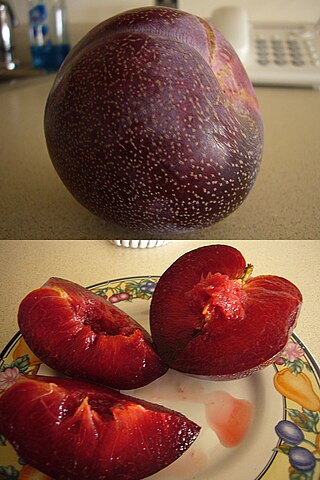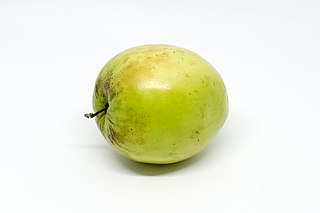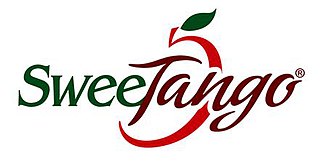
Pluots, apriums, apriplums, plumcots or pluclots are some of the hybrids between different Prunus species that are also called interspecific plums. Whereas plumcots and apriplums are first-generation hybrids between a plum parent and an apricot, pluots and apriums are later-generations. Both names "plumcot" and "apriplum" have been used for trees derived from a plum seed parent, and are therefore equivalent.

A melon is any of various plants of the family Cucurbitaceae with sweet, edible, and fleshy fruit. The word "melon" can refer to either the plant or specifically to the fruit. Botanically, a melon is a kind of berry, specifically a "pepo". The word melon derives from Latin melopepo, which is the latinization of the Greek μηλοπέπων (mēlopepōn), meaning "melon", itself a compound of μῆλον (mēlon), "apple", treefruit " and πέπων (pepōn), amongst others "a kind of gourd or melon". Many different cultivars have been produced, particularly of cantaloupes.

Golden Delicious is a cultivar of apple. It is one of the 15 most popular apple cultivars in the United States. It is not closely related to Red Delicious.

The tangelo, Citrus × tangelo, is a citrus fruit hybrid of a Citrus reticulata variety, such as mandarin orange or tangerine, and a Citrus maxima variety, such as a pomelo or grapefruit. The name is a portmanteau of 'tangerine' and 'pomelo'.

The Haralson is a cultivar of apple that is medium-sized and has a round-conic shape.

Ziziphus mauritiana, also known as Indian jujube, Indian plum, Chinese date, Chinese apple, ber and dunks is a tropical fruit tree species belonging to the family Rhamnaceae. It is often confused with the closely related Chinese jujube, but whereas Z. jujuba prefers temperate climates, Z. mauritiana is tropical to subtropical.

Honeycrisp is an apple cultivar developed at the Minnesota Agricultural Experiment Station's Horticultural Research Center at the University of Minnesota, Twin Cities. Designated in 1974 with the MN 1711 test designation, patented in 1988, and released in 1991, the Honeycrisp, once slated to be discarded, has rapidly become a prized commercial commodity, as its sweetness, firmness, and tartness make it an ideal apple for eating raw. "...The apple wasn't bred to grow, store or ship well. It was bred for taste: crisp, with balanced sweetness and acidity." It has larger cells than most apple cultivars, a trait which is correlated with juiciness, as larger cells are more prone to rupturing instead of cleaving along the cell walls; this rupturing effect is likely what makes the apple taste juicier. The Honeycrisp also retains its pigment well and has a relatively long shelf life when stored in cool, dry conditions. Pepin Heights Orchards delivered the first Honeycrisp apples to grocery stores in 1997. The name Honeycrisp was trademarked by the University of Minnesota, but university officials were unsure of its protection status in 2007. It is now the official state fruit of Minnesota. A large-sized honeycrisp will contain about 113 calories.

The 'Pink Pearl' apple is a pink-fleshed apple cultivar developed in 1944 by Albert Etter, a northern California breeder. It is a seedling of 'Surprise', another pink-fleshed apple that is believed to be a descendant of Malus niedzwetskyana.

Antonovka is a group of late-fall or early-winter apple cultivars with a strong acid flavor that have been popular in Russia, including during Tsarist and Soviet times, as well as in Poland and Belarus. The most popular Russian variety is the Common Antonovka, from which other cultivars are derived. Some varieties of Antonovka were bred by pioneer Russian naturalist and plant breeder Ivan V. Michurin at his experimental orchard in the Tambov Oblast and introduced in 1888.

Annona mucosa is a species of flowering plant in the custard-apple family, Annonaceae, that is native to tropical South America. It is cultivated for its edible fruits, commonly known as biribá, lemon meringue pie fruit, or wild sugar-apple, throughout the world's tropics and subtropics.

An apple is a round, edible fruit produced by an apple tree. Apple trees are cultivated worldwide and are the most widely grown species in the genus Malus. The tree originated in Central Asia, where its wild ancestor, Malus sieversii, is still found. Apples have been grown for thousands of years in Eurasia and were introduced to North America by European colonists. Apples have religious and mythological significance in many cultures, including Norse, Greek, and European Christian tradition.

In viticulture, ripeness is the completion of the ripening process of wine grapes on the vine which signals the beginning of harvest. What exactly constitutes ripeness will vary depending on what style of wine is being produced and what the winemaker and viticulturist personally believe constitutes ripeness. Once the grapes are harvested, the physical and chemical components of the grape which will influence a wine's quality are essentially set so determining the optimal moment of ripeness for harvest may be considered the most crucial decision in winemaking.

SweeTango is the brand name of the cultivated apple 'Minneiska'. It is a cross between the 'Honeycrisp' and the Zestar Apple belonging to the University of Minnesota. The apple is controlled and regulated for marketing, allowing only exclusive territories for growing. It has a sweet-tart taste that some food writers have described as something between brown sugar and spiced apple cider.

Thomcord is a seedless table grape variety and a hybrid of the popular Thompson Seedless or Sultanina grape and Concord grape. Thomcord was developed in 1983 by Californian grape breeders working for the Agricultural Research Service (ARS), an agency of the United States Department of Agriculture (USDA), as part of a test to better understand a new seedless grape breeding procedure.

'Honeygold' is a cold-hardy cultivar of domesticated apple, which was developed to suit for the northern cold areas. It was developed by the Minnesota Agricultural Experiment Station's Horticultural Research Center of the University of Minnesota. They were crossing a Golden Delicious with a Haralson in order to obtain a Golden Delicious style fruit with the cold hardiness of the Haralson, a goal which was successfully achieved.

Cosmic Crisp is an American apple with the variety designation 'WA 38'. Breeding began in 1997 at the Washington State University (WSU) Tree Fruit Research and Extension Center in Wenatchee, Washington, and was initially overseen by Bruce Barritt. Kate Evans completed the research after Barritt's retirement from WSU.
Sweet Sixteen is a cultivar of domesticated apple.

The MN55 cultivar apple developed by David Bedford, a senior researcher and research pomologist at the University of Minnesota's apple-breeding program, and James Luby, PhD, professor, Department of Horticultural Sciences, Horticultural Research Center, is a cross between Honeycrisp and MonArk (AA44), a non-patented apple variety grown in Arkansas.
EverCrisp is an American apple cultivar developed by the Midwest Apple Improvement Association (MAIA). Trademarked as EverCrisp, the MAIA-1 variety is a cross between two existing apple cultivars: the Honeycrisp and Fuji. Originally produced in Ohio, EverCrisp has since expanded to apple-growing regions across the Midwest in Michigan, Illinois and Indiana, in the Northeast in Pennsylvania and New York, and in the Northwest in Washington. The apple entered the public marketplace in 2017.

Honeynut squash is an interspecific hybrid winter squash cultivar bred from butternut and buttercup squash. It has dark tan to orange skin with orange fleshy pulp. When ripe, it turns from green to a deep orange and becomes sweeter and richer. Honeynut squash has a similar shape and flavor to butternut squash but averages about half the size and is sweeter. It has two to three times more beta-carotene than butternut squash. Honeynut squash can be roasted, sautéed, puréed, added to soups, stews, and braises, and has enough sugar content for desserts.


















